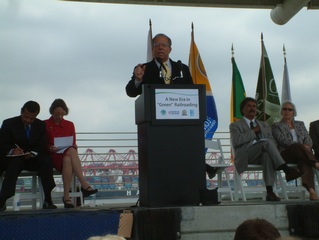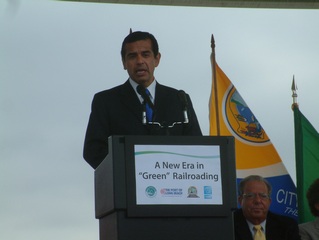July 11, 2007, port and elected
officials, along with Pacific Harbor Line personnel gathered to
celebrate the commissioning of new low emission locomotives. The
dual ports of Long Beach and Los Angeles, two separate entities, make
up the fifth largest port complex in the world. It is served by
numerous shipping lines bringing in many different types of cargo,
ranging from containers of all types of goods, bulk commodities and
automobiles. The ports are served by a shortline railroad, the
Pacific Harbor Line or PHL, which interchanges with two Class I
railroads, the BNSF Railway and Union Pacific Railroad. Most of the
rail traffic utilizes the Alameda Corridor, a modernized rail line
connecting the ports to the downtown Los Angeles railyards. This
dedicated, grade separated project opened in April 2002 to great
fanfare. By consolidating rail lines and eliminating rail and
vehicular grade crossings, time is saved for trains heading to and from
the port. The public's benefit is less time spent waiting for
trains to pass. The ports, by nature contribute air particulate
matter and greenhouse gases through vessel powerplants which are left
running while in the harbor or at berth, tractors hauling containers
around the port, and locomotives moving trains in, out and around the
port.
According to the Clean-Diesel Locomotives Fact Sheet, "...emissions
reductions are a key element to the San Pedro Bay Ports Clean Air
Action Plan, approved in November 2006 by the Long Beach and Los
Angeles boards of harbor commissioners."
There were about 100-125 people at
the Hanjin Terminal on the grounds
of the old Naval Base Long Beach. Acting as emcees were Dr.
Geraldine Knatz (Executive Director, Port of LA) and Richard Steinke
(Executive Director, Port of LB) . They joked that
while they are competitors, they are on the same team for clean
air. The focus of the day’s event is “green” railroading.
Both the mayors of Long Beach and Los Angeles were in attendance as
well as members of both harbor commissions, railroad officials, and a
representative of the Governor Arnold Schwarzenneger
The first speaker was Long Beach
Mayor Bob Foster who
mentioned that the new locomotives achieve a 70% reduction in
particulates
and a 40% reduction in nitrous oxides. The ports must maintain a
balance between health impacts and economic good which can be
accomplished through teamwork and political will.
The next
speaker was Los Angeles Mayor Antonio Villaraigosa who thanked
Geraldine Knatz, Mr. Steinke
and LA City Councilwoman Janice Hahn. He stated that the ports
are growing, working and
coordinating together to grow bigger. The cities and ports formed
partnerships with business,
labor and neighborhoods and crafted the plan for green
locomotives and trucks. Even with a plan for 50% reduction of
pollution in 5
years, some want to close the port due to health risks which would kill
the economy. Mindful of of testimony that port neighborhood kids
are
sick due to pollution, Villaraigosa said there is "no excuse for half
measures or
failure." The future depends on sustained growth with one out of
24 jobs (in the five county region) being
port related.
Villaraigosa is excited because he authored the Carl Moyer program for
incentives for clean fuel vehicles while in the state
legislature. The focus is on trucks and low sulfur emission on
ships. He suggested to work together to grow greener, leaner and
cleaner. Someone started a running joke about alma mater, so
Villaraigosa made mention of being a graduate of UCLA.


Next was Tonia Reyes Uranga,
Councilwoman, City of Long Beach & South Coast Air Quality
Management District board member and fellow Bruin who exclaimed “I love
those
trains!” The AQMD was responsible for a $7 million contribution
to the locomotive replacement
program. Her three main points were: 1) to
recognize the ports of LB and LA and PHL. A clean up strategy was
incorporated into a contract extension (through 2018) for PHL.
Some of the
railroad equipment being replaced is 50 years old; 2) recognize
local
community leaders to raise health impact versus local shipping
operations; 3) AQMD is serious in "meeting standards sooner than
later." She pointed out that it is challenging to clean up
emissions due to monetary constraints, engineering and other
factors. The AQMD has helped clean up industrial and automotive
pollution. Now ships, trucks and trains are to meet simiilar
standards as other transportation technology.
Next
speaker was Janice Hahn, Councilwoman, City of
Los Angeles, and Pepperdine graduate. She called the dual port
complex “America’s port” since the global economy depends on
LB/LA. She was excited to have been involved in plugging in the
first China Shipping vessel at the green terminal on the LA side.
One ship can emit 7 tons per day of pollution. With 5000 workers
on the docks on a
daily basis, we can have growth
and clean air, but we "should not bear the burden of bad health for the
rest of the country."
Below left, Tonia Reyes Uranga, City of Long Beach Councilwoman
and
SCAQMD board member.
Below right, City of Los Angeles Councilwoman, Janice Hahn.
Next
speaker was Long Beach Harbor Commission
President Mario Cordero who pointed out that it takes many to attain
the clean air objective. Mr. Cordero asked a series of rhetorical
questions starting with the dual ports of LB/LA being the "center of
the global economy" ... "but how to
stay there?" Business will grow. How to grow
responsibily? How to deal with impact of health issues?
Made these issues top priority. His organization has worked with
PHL, the AQMD, and the Port of Los Angeles "to make PHL the most
environmentally friendly switching railroad in the nation."
S. David Freeman was appointed to the
LA Harbor Commission by Mayor
Villaraigosa and confimed September 9, 2005. This management veterans
words were brief, and aside from thanking LA Harbor Commission
counterpart James Hankla (former head of the Alameda Corridor
Transportation Agency) and the two Class I railroads, Union Pacific
and BNSF Railway, Mr. Freeman said they were "on the march for a
cleaner port." Mr. Freeman has held high profile public works
positions over the last 30 years, including chairmanship of the
Tennessee Valley Autority and head of the City of Los Angeles
Department of Water and Power during the power crisis of the early
2000's. His Port of Los Angeles biography page credits him with
"devotion to clean air, clean water, and renewable energy.".
Below left, Mario Cordero, President, Long Beach Harbor
Commission, California State University Long Beach Alumni.
Below right, S. David Freeman, President, Los Angeles
Harbor Commission.
Billie Greer, Los Angeles
Director, Office of Governor
Arnold Schwarzenegger, thanked PHL and the entire green
fleet, as the
locomotive replacement program would help to "slash carbon
emmissions." She called Governor Arnold Schwarzenegger and
Mayors Antonio Villaraigosa and Bob Foster "green
warriors". Greer
thanked PHL for "stepping up to the plate" regarding locomotive
replacment and that the state was "proud to contribute
funding." She further commented that Cailifornia is
growning a new economy based on "green" which will produce tens of
thousands of new jobs. She equated PHL with a seam roller.
In his remarks, Peter Gilbertson,
CEO,
Anacostia and Pacific Co. and Chairman, Pacific Harbor Line pointed out
that Pacific Harbor Line was established 12
years ago to be a "neutral, fair, and transparent swithcing operation"
at the ports. This type of operation actually finds it "efficient
to operate 50 year old locomotives. They are cheap to
have." While the new locomotives cost $1.3 million each, PHL
decided to help address the environmental issues by contibuting $10
million to the replacement program. Mr. Gilbertson also
stated that the locomotive order was increased to include 3 additional
Tier 3 compliant locomotives. The efficiency of rail transport
takes over one million trucks off the road for short haul trips from
the docks to near dock rail facilities. He further stated that
greenhouse gases emmited by freight railroads amounts to one third the
amount
emmitted by recreational boats. PHL maintains a small fleet of
hybrid automobiles. He touted that PHL was one of 4 other
shortline railroads in the EPA Smartway Program in swhich railroads
"will adopt green measures." The U.S. EPA Smartway
Transport Partnership promotes fuel efficiency and reduction of
greenhouse gases within the freight industry. Mr. Gilbertson
stated that "PHL wants to be part of the solution" at the green
port. His thank you list ranged from the Ports of LB/LA to
participate, SCAQMD, MotivePower Inc., and MTU Diesel. Regarding
MTU Diesel, Mr. Gilbertson said this is the first application of MTU
Diesel power in locomotives. He finsihed his remarks by
recognizing all Pacific Harbor Line employees.
Below left, Billie Greer, Los Angeles
Director, Office of Governor
Arnold Schwarzenegger.
Below right, Peter Gilbertson, CEO,
Anacostia and Pacific Co. and Chairman, Pacific Harbor Line.
The final speaker was Don Hahs,
President,
Brotherhood of Locomotive Engineers
and Trainmen. Mr. Hahs started his remarks on a humorous note by
acknowledging the previous speakers had used his speaking points 4
times over. Mr. Hahs thanked the three railroads, BNSF Railway,
Union Pacific and Pacific Harbor Line. He commented that PHL
trainmen move 2 million containers annually while cutting 10,000 trucks
daily.. He told us to "imagine traffic without the
railroads." He called the locomotive replacement program a
progressive model of public and private cooperation and "good business
for all involved." PHL started with 17 people and has grown to
100 people. They are moving lots of freight with fewer good
people. His last coment was another gem, saying to "keep on
truckin, but do as much as possible by train."
After Mr. Hahs, Mayor Villaraigosa made a brief speach in Spanish.
Below right, Andrew Fox, President
Pacific Harbor
Line, and other PHL personnel.
Below left, Don Hahs, President,
Brotherhood of Locomotive Engineers
and Trainmen.
PHL locomotives 62 and 63 were
displayed nose to nose for the tape breaking ceremony. This sight
made me think of the May 10, 1869 Golden Spike Ceremony with number 119
and Jupiter at Promontory Summit Utahand and having made my first
visit to the
Golden Spike Historical Site less than two weeks before this
event. What would 19th century railroaders think of low emission
diesel locmotives and 1-1/2 mile long 10,000 ton trains? Single
PHL locomotives routinely move extremely long intermodal trains around
the port area. After the dignitaries took their places, the
locmotives pulled away, thus breaking the tape.